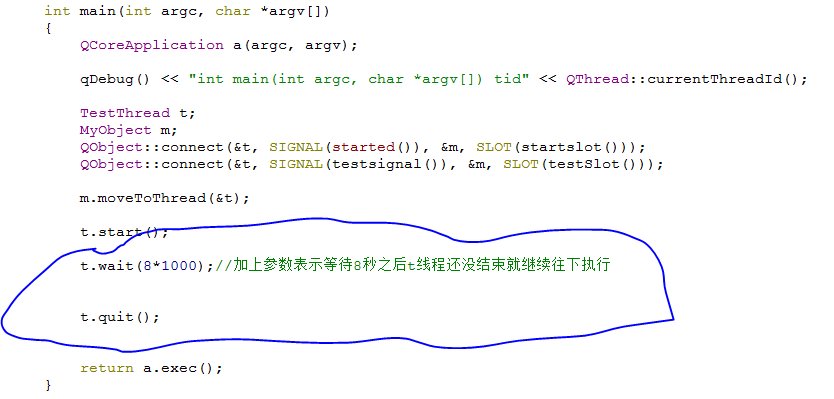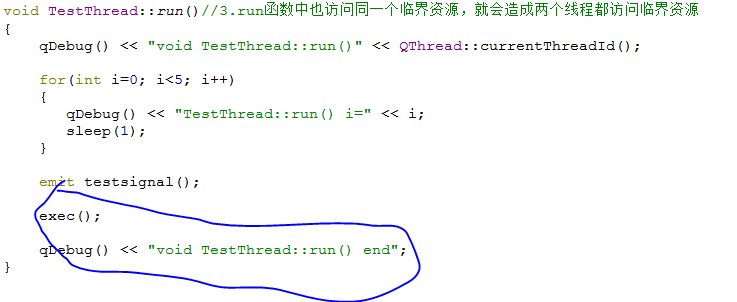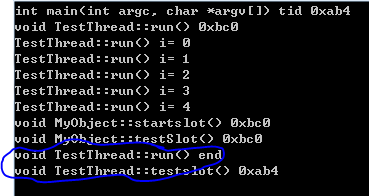一、线程体函数开启了事件循环,线程如何正常结束
1、QThread::exec()使得线程进入事件循环
(1)、事件循环结束前,exec()后的语句无法执行
(2)、quit()和exit()函数用于结束事件循环
(3)、quit() <---->exit(0),exec()的返回值由exit()参数决定
2、注意
(1)、无论事件循环是否开启,信号发送后会直接进入所依附线程的事件队列
(2)、然而,只有开启了事件循环,对应的槽函数才会在线程中被调用



二、什么时候需要开启事件循环
1、设计原则
(1)、事务性操作(间断性IO操作,等)可以开启线程的事件循环
(2)、每次操作通过发送信号的方式使得槽函数在子线程中执行
2、概念小科普:文件缓冲区(文件操作是事务性操作)
(1)、默认情况下,文件操作时会开辟一段内存作为缓冲区
(2)、向文件中写入的数据会先进入缓冲区
(3)、只有当缓冲区满或者遇到换行符时才将数据写入磁盘
(4)、缓冲区的意义在于:减少磁盘的低级IO操作,提高文件读写效率(但存在风险)
3、Qt线程的使用模式
(1)、无事件循环模式:后台执行常时间的耗时任务(文件复制、网络读取等)
(2)、开启事件循环模式:执行事务性操作(文件写入,数据库写入等)
开启一个线程,线程里边只需要开启事件循环,然后将槽函数,通过对象的依附性转移来将槽函数移到线程执行,最后不要忘了在析构函数中终止线程的执行

#ifndef FILEWRITE_H #define FILEWRITE_H #include <QObject> #include <QFile> #include <QString> #include <QThread> class FileWrite : public QObject { Q_OBJECT private: class writeThread : public QThread//记得是public继承 { protected: void run(); }; QFile* m_file; writeThread thread; public: explicit FileWrite(QString path, QObject *parent = 0); bool fileOpen(); void fileWrite(const char* text); void fileClose(); signals: void testWrite(const char* text); void testClose(); protected slots: void writeSlot(const char* text); void closeSlot(); }; #endif // FILEWRITE_H

#include "FileWrite.h" #include <QIODevice> #include <QDebug> FileWrite::FileWrite(QString path, QObject *parent) : QObject(parent) { m_file = new QFile(path, this); connect(this, SIGNAL(testWrite(const char*)), this, SLOT(writeSlot(const char*))); connect(this, SIGNAL(testClose()), this, SLOT(closeSlot())); moveToThread(&thread);//这句话极其重要,将槽函数移到线程中执行 thread.start(); } bool FileWrite::fileOpen() { return m_file->open(QIODevice::WriteOnly | QIODevice::Text); } void FileWrite::fileWrite(const char* text) { emit testWrite(text); } void FileWrite::fileClose() { emit testClose(); } FileWrite::~FileWrite()//析构函数中终止线程执行 { thread.quit(); } /**************************************槽函数******************************************/ void FileWrite::writeSlot(const char* text) { qDebug() << "void FileWrite::writeSlot(const char* text) tid = " << QThread::currentThreadId(); m_file->write(text); m_file->flush();//每次写的时候都直接写入文件,进行低级的IO操作,比较耗时 } void FileWrite::closeSlot() { qDebug() << "void FileWrite::closeSlot() tid= " << QThread::currentThreadId(); m_file->close(); } /***********************************线程的函数*****************************************/ void FileWrite::writeThread::run() { qDebug() << "void FileWrite::writeThread::run() tid= " << QThread::currentThreadId(); exec(); }

#include <QtCore/QCoreApplication> #include "FileWrite.h" int main(int argc, char *argv[]) { QCoreApplication a(argc, argv); FileWrite file("C:/Users/LGC/Desktop/test.txt"); if(file.fileOpen()); { file.fileWrite("Hello word "); file.fileWrite("你好,世界 "); file.fileWrite("狄泰软件学院,成就梦想 "); file.fileClose(); } return a.exec(); }

三、小结
(1)、QThread::exec()使得线程进入事件循环
(2)、quit() <---->exit(0)用于结束线程的事件循环并返回
(3)、事务性操作可以开启线程的事件循环,将操作分摊到子线程
(4)、工程开发中,多数情况不会开启线程的事件循环
(5)、线程多用于执行后台任务或者耗时操作
